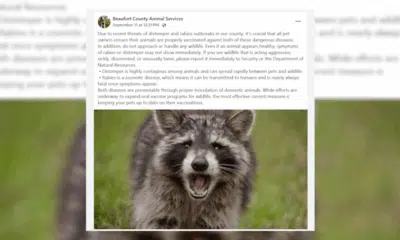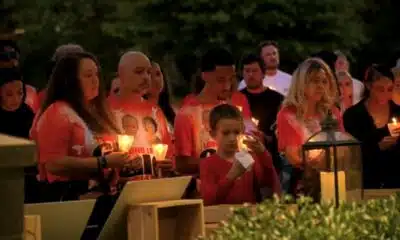News from the South - North Carolina News Feed
Daughter’s six-week search for missing parents marked by miscommunication, false sightings, DNA samples • Asheville Watchdog
Asheville Watchdog is bringing you the stories behind the staggering loss of life from Helene, the children, parents, grandparents, multiple generations of a single family, all gone in one of the worst natural disasters to hit the mountains of western North Carolina. This is the ninth installment.
The sorrow and torment are sadly familiar by now: A daughter desperately searching for her missing parents only to discover they were never coming back.
Nola and Robert Ramsuer died when floodwaters overtook their Swannanoa riverside trailer in Tropical Storm Helene.
But for daughter Shalana Jordan, getting to that agonizing answer took six weeks and included multiple searches through mud-caked debris, repeated calls to aid agencies, false sightings from well-meaning strangers, and a bureaucratic labyrinth that often appeared inept at tracking the missing and the dead.
Read previous installments of The Lives We Lost.
The Ramsuers, both 70, were among the 43 officially lost in Buncombe County to the Sept. 27 storm.
For loved ones left behind, navigating a chaotic disaster even with help pouring in from across the U.S. can be frustratingly slow and painful.
For Jordan, 40, of Winston Salem, it meant days of scouring social media posts and helicopter footage for clues about her parents, sending friends and relatives to shelters to see if they were there, providing DNA samples not once but twice, and waiting six weeks for confirmation that remains found within 10 days of the storm were those of her mother and father.
Jordan, mother of two boys, Aiden, 8, and P.J., 9, had to juggle their school needs and her own chemotherapy for a genetic disorder while searching for answers.
Holding onto hope amid the wreckage
On the morning of the storm, Jordan texted with her mother as she usually did. Around 7:30 a.m., her mother reported the power had gone out.
“She said it, like, almost funny…‘It’ll come back on again later,’” Jordan said. “She stopped texting me around eight.”
Jordan assumed her mother had gone to work at her custodian’s job at the Black Mountain Neuro-Medical Treatment Center. Her father, a Vietnam War veteran who had been in declining health, still worked a couple of days a week in maintenance for Cracker Barrel.

When Jordan couldn’t reach them that night, she figured they’d gone to bed early. The next day, images of the destruction began appearing on social media.
“I messaged all my family in Asheville, thinking maybe they called one of them and were with them, or maybe they didn’t have their phones,” Jordan said.
Over the next hours and days, she searched a Swannanoa Facebook page, scanning photos of water pickup and donation sites for any signs of her parents. She watched hours of helicopter video footage and finally spotted her parents’ trailer park on Avery Wood Drive. Many of the trailers were gone.
Benjamin Larrabee, the Ramsuers’ next-door neighbor, recorded videos of the floodwater surging through the trailer park, sweeping up semi-tractor trailers and pushing them downstream past the Ramsuers’ home.
“Man, the whole trailer just moved,” Larrabee can be heard saying on one video as the water carried two semis past the Ramsuers. “Oh man, I hope these guys are going to be all right.”
One of the trucks eventually crashed into the Ramsuers’ trailer, ripping off one end, Jordan said.
Inside, she said, the water came up to the hood above the stove; a couch had been lifted off the floor and landed on the kitchen counter.
Neither of her parents could swim. But their home was still standing.
Jordan held out hope that maybe they made it to a shelter but determining that proved no easy task.
“During all of the first three weeks, we were checking shelters,” Jordan said. “There weren’t any lists of who was in the shelters. I had to physically send people there while I was in Winston Salem.”

Jordan posted about her parents on social media and gave interviews to national media in hopes of generating leads. Her phone pinged non-stop with hopeful, but false tips.
“People message you and comment on your posts all day, every day, from six in the morning until 2 a.m. at night,” she said. “‘I think I saw them here. I think I saw them there.’”
Jordan made the two-hour trip to her parents’ home four times, traipsing through mud and debris outside and inside the trailer with relatives and her fiance, Edward Jordan. “The mud was so thick in one of the back bedrooms, I was like, what if they’re in here in the mud, and we’re walking over them?” she said.
Her own health made searching difficult. Jordan’s legs and ankles swell, and chemo leaves her weak and in pain, she said.
At one point, she injured her ankle in the remnants of the trailer. “I fell through the floor,” Jordan said, “because it was getting soft from all the mud and the moisture.”
Jordan called every government and aid agency she could think of to report her parents missing.

“Nobody would take a description of them. No one would take photos. It was crazy,” she said. “I know that it was an unprecedented situation, but FEMA, [the American] Red Cross, like they do this every day. Disaster is their only job.”
An arduous wait for confirmation
Sixteen days after the storm, Jordan said she received a call from a Buncombe sheriff’s executive asking for a description of the clothes her parents were wearing.
Three days later, “I got a call from the medical examiner in Raleigh saying that they think they found my parents,” Jordan said.
She did not know then, but death certificates completed later showed her mother’s body had been found Oct. 4, and her father’s Oct. 7, more than a week earlier.
“We were hunting and wasting resources this whole time,” Jordan said, “if we could have been allowed to identify bodies, or if someone had been in charge of missing persons, to say we recovered X, Y and Z bodies.

“How many resources did I waste that could have been used helping someone else or finding someone else because we had tons of community help, people searching on foot, cadaver dogs, people shoveling out mud for us?”
Dr. Craig Nelson at the Office of Chief Medical Examiner in Raleigh told Jordan the bodies believed to be her parents still had to be transported to Raleigh for examination and confirmation, she said.
Around the same time, the Buncombe Sheriff’s Office had been in contact with Jordan and sent a Winston Salem police officer to her home to collect DNA samples to match them against the remains.
The same day, about 20 minutes later, Nelson called to arrange to collect her DNA. Jordan told him, “They already came, and he was like, ‘What are you talking about?’”
Nelson said he would look into it and called back to say the first sample was headed to a Buncombe County lab, and results would take three to six weeks, Jordan said.
The Raleigh medical examiner’s lab could match the sample faster, in about a week, but she would need to provide a second round of DNA, “so more officers came and got samples,” Jordan said.
In early November, Nelson delivered the results.
“He said, ‘I’m so sorry,’” Jordan said. “My parents remains’ broke down too much during this process, and they couldn’t even get anything from their DNA samples.”
More samples were collected from the remains, and the medical examiner’s office conducted another round of testing. “We had to wait another week,” Jordan said.
She said Nelson “went above and beyond” and kept her updated daily.
The medical examiner’s office did not respond to a request for comment by deadline.
On Nov. 12, more than six weeks after the storm and five weeks after her parents’ bodies had been found, Jordan received official confirmation of their deaths.
By then, the family had already held a memorial service. Jordan said she did not want to wait with unpredictable winter weather approaching.
And she said she knew in her heart her parents were gone, especially after the discovery of a plastic bag inside their trailer with her mother’s purse, her father’s wallet, debit cards and mementos. She thinks they were planning an escape.
Also inside the bag: her mother’s cell phone, the same one she’d been texting and calling for days.
“She didn’t even have her phone,” Jordan said. “We were all just texting no one.”
Memorial brings unexpected costs, tributes
The Ramsuers’ funeral and cremation costs totaled more than $3,000 and included a “transport fee” to drive their remains from Raleigh to a funeral home in Swannanoa, Jordan said. “It’s $3 a mile to transport a body,” she said.
Cracker Barrel, her father’s employer, catered the memorial service and paid a portion of the costs, she said. The Red Cross paid the transport fee and other expenses.
The Federal Emergency Management Agency declined to pay, she said, because her father was entitled to funeral benefits as a veteran, about $300. With community donations, Jordan said the family expects to be fully reimbursed for the funeral costs.
Jordan said she’s heard from many of her parents’ friends, neighbors and co-workers, “the only good thing out of all this,” she said. “Not a handful, not dozens, but hundreds of people.”
Robert Ramsuer, a Buncombe native, served in the U.S. Army. “He saw a lot of crazy stuff” in Vietnam and served two tours after the war, his daughter said.
She described him as a spitfire who always had a story to tell. He loved fishing and hunting.
“People messaged me saying, ‘Your dad taught me how to fish 40 years ago; your dad taught me martial arts 30 years ago,’” Jordan said.
Nola Ramsuer was “very soft spoken and sweet,” she said. She baked cakes for friends’ and coworkers’ birthdays and hosted Christmas for their extended family.

One former coworker told Jordan how he’d talked to her mother about the many medications he was taking for lupus, an autoimmune disorder Jordan also has. Her mother went online and researched alternatives “and sent him these printouts of holistic things he could try to be able to get off all the medication,” Jordan said.
‘Life is so fragile’
Jordan recently collected her parents’ ashes from the Penland Family Funeral Home in Swannanoa. She said she purchased two memorial boxes, each a size large accommodating the remains of a 300-pound person, more than enough for her 140-pound father and 110-pound mother.
But Jordan said a funeral home representative informed her that her mother had been found in the mud.
He said, “‘We tried to remove as much material from her as we could, but there still was a lot mixed in, so all of her doesn’t fit inside of the box,’” Jordan said.
She said she received two boxes with her mother’s remains.
Funeral home representatives did not respond to messages seeking comment.
Jordan said that while her father had been ill, she expected to have another 20 or 30 years with her mother, who came from a family in which women lived well into their 90s, one making it to 104.
“I thought I had more time,” Jordan posted on Facebook. “Life is so fragile and can be gone in an instant.”
Asheville Watchdog is a nonprofit news team producing stories that matter to Asheville and Buncombe County. Sally Kestin is a Pulitzer Prize-winning investigative reporter. Email skestin@avlwatchdog.org. The Watchdog’s reporting is made possible by donations from the community. To show your support for this vital public service go to avlwatchdog.org/support-our-publication/.
Related
The post Daughter’s six-week search for missing parents marked by miscommunication, false sightings, DNA samples • Asheville Watchdog appeared first on avlwatchdog.org
News from the South - North Carolina News Feed
White House officials hold prayer vigil for Charlie Kirk
SUMMARY: Republican lawmakers, conservative leaders, and Trump administration officials held a prayer vigil and memorial at the Kennedy Center honoring slain activist Charlie Kirk, founder of Turning Point USA. Kirk was killed in Utah, where memorials continue at Utah Valley University and Turning Point USA’s headquarters. Police say 22-year-old Tyler Robinson turned himself in but has not confessed or cooperated. Robinson’s roommate, his boyfriend who is transitioning, is cooperating with authorities. Investigators are examining messages Robinson allegedly sent on Discord joking about the shooting. Robinson faces charges including aggravated murder, obstruction of justice, and felony firearm discharge.
White House officials and Republican lawmakers gathered at the Kennedy Center at 6 p.m. to hold a prayer vigil in remembrance of conservative activist Charlie Kirk.
https://abc11.com/us-world/
Download: https://abc11.com/apps/
Like us on Facebook: https://www.facebook.com/ABC11/
Instagram: https://www.instagram.com/abc11_wtvd/
Threads: https://www.threads.net/@abc11_wtvd
TIKTOK: https://www.tiktok.com/@abc11_eyewitnessnews
News from the South - North Carolina News Feed
Family, friends hold candlelight vigil in honor of Giovanni Pelletier
SUMMARY: Family and friends held a candlelight vigil in Apex to honor Giovanni Pelletier, a Fuquay Varina High School graduate whose body was found last month in a Florida retention pond. Giovanni went missing while visiting family, after reportedly acting erratically and leaving his cousins’ car. Loved ones remembered his infectious smile, laughter, and loyal friendship, expressing how deeply he impacted their lives. His mother shared the family’s ongoing grief and search for answers as authorities continue investigating his death. Despite the sadness, the community’s support has provided comfort. A celebration of life mass is planned in Apex to further commemorate Giovanni’s memory.
“It’s good to know how loved someone is in their community.”
More: https://abc11.com/post/giovanni-pelletier-family-friends-hold-candlelight-vigil-honor-wake-teen-found-dead-florida/17811995/
Download: https://abc11.com/apps/
Like us on Facebook: https://www.facebook.com/ABC11/
Instagram: https://www.instagram.com/abc11_wtvd/
Threads: https://www.threads.net/@abc11_wtvd
TIKTOK: https://www.tiktok.com/@abc11_eyewitnessnews
News from the South - North Carolina News Feed
NC Courage wins 2-1 against Angel City FC
SUMMARY: The North Carolina Courage defeated Angel City FC 2-1 in Cary, ending their unbeaten streak. Monaca scored early at the 6th minute, followed by Bull City native Brianna Pinto’s goal at the 18th minute, securing a 2-0 halftime lead. Angel City intensified in the second half, scoring in the 88th minute, but the Courage held firm defensively to claim victory. Pinto expressed pride in the win, emphasizing the team’s unity and playoff ambitions. Nearly 8,000 fans attended. Coverage continues tonight at 11, alongside college football updates, including the Tar Heels vs. Richmond game live from Chapel Hill.
Saturday’s win was crucial for the Courage as the regular season starts to wind down.
https://abc11.com/post/north-carolina-courage-wins-2-1-angel-city-fc/17810234/
Download: https://abc11.com/apps/
Like us on Facebook: https://www.facebook.com/ABC11/
Instagram: https://www.instagram.com/abc11_wtvd/
Threads: https://www.threads.net/@abc11_wtvd
TIKTOK: https://www.tiktok.com/@abc11_eyewitnessnews
-
News from the South - North Carolina News Feed6 days ago
What we know about Charlie Kirk shooting suspect, how he was caught
-
Local News7 days ago
Russian drone incursion in Poland prompts NATO leaders to take stock of bigger threats
-
News from the South - North Carolina News Feed6 days ago
Federal hate crime charge sought in Charlotte stabbing | North Carolina
-
Local News Video7 days ago
Introducing our WXXV Student Athlete of the Week, St. Patrick’s Parker Talley!
-
The Center Square7 days ago
Weapon recovered as manhunt continues in Kirk assassination investigation | National
-
Our Mississippi Home5 days ago
Screech Owls – Small but Cute
-
News from the South - Arkansas News Feed6 days ago
NW Arkansas Championship expected to bring money to Rogers
-
News from the South - Tennessee News Feed7 days ago
Middle Tennessee State University dean filed over Kirk comments | Tennessee
















































